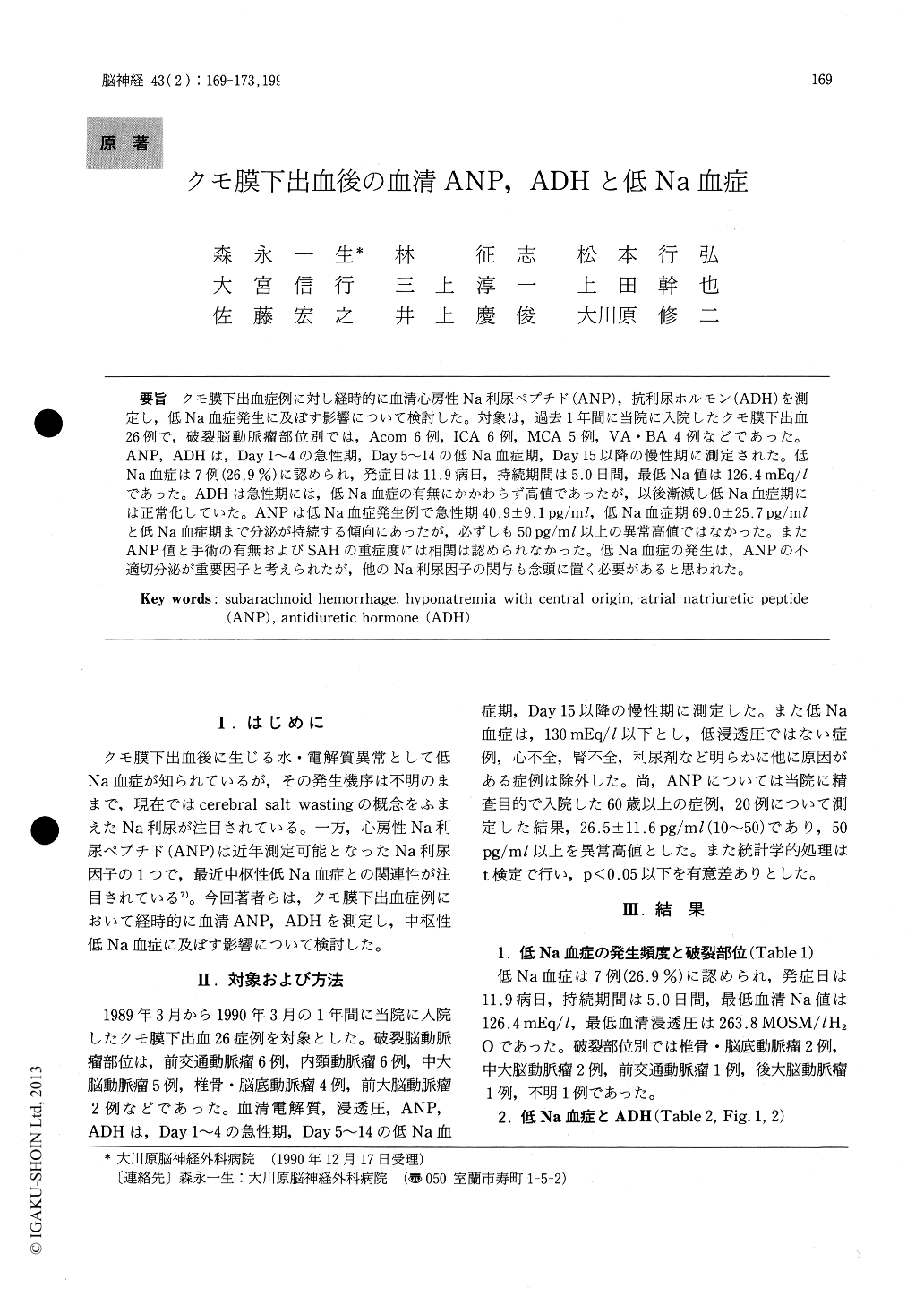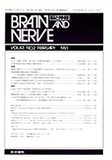Japanese
English
- 有料閲覧
- Abstract 文献概要
- 1ページ目 Look Inside
クモ膜下出血症例に対し経時的に血清心房性Na利尿ペプチド(ANP),抗利尿ホルモン(ADH)を測定し,低Na血症発生に及ぼす影響について検討した。対象は,過去1年間に当院に入院したクモ膜下出血26例で,破裂脳動脈瘤部位別では,Acom 6例,ICA 6例,MCA 5例,VA・BA 4例などであった。ANP,ADHは,Day 1〜4の急性期,Day 5〜14の低Na血症期,Day 15以降の慢性期に測定された。低Na血症は7例(26.9%)に認められ,発症日は11.9病日,持続期間は5.0日間,最低Na値は126.4mEq/lであった。ADHは急性期には,低Na血症の有無にかかわらず高値であったが,以後漸減し低Na血症期には正常化していた。ANPは低Na血症発生例で急性期40.9±9.1pg/ml,低Na血症期69.0±25.7pg/mlと低Na血症期まで分泌が持続する傾向にあったが,必ずしも50pg/ml以上の異常高値ではなかった。またANP値と手術の有無およびSAHの重症度には相関は認められなかった。低Na血症の発生は,ANPの不適切分泌が重要因子と考えられたが,他のNa利尿因子の関与も念頭に置く必要があると思われた。
We determined serum atrial natriuretic peptide (ANP) and anti-diuretic hormone (ADH) on a time course basis in cases of subarachnoid hemorrhage and studied their influence on the development of hyponatremia.
Twenty six cases of subarachnoid hemorrhage were admitted to our hospital in the past 1 year, and by the site of ruptured aneurysms, there were Acom 6 cases, ICA 6 cases, MCA 5 cases and VA-BA 4 cases. Serum ANP and ADH levels were deter-mined in the acute phase on Day 1-4, in the hyponatremia phase on Day 5-14 and in the chronic phase on Day 15 downward. Levels of not more than 130 mEq/l were regarded as hyponatremia. Cases showing other evident causes such as heart failure and renal insufficiency were excluded. In the normal control group (n=20) which was admitted to this hospital for a close check-up, serum ANP was 26.5 ± 11.6 pg/m/ (10-50) ; levels of more than 50 pg/ml were regarded as being abnormally high. 1) Hyponatremia was observed in 7 cases (26. 9%) ; the day of onset was 11.9 hospital day. The duration was 5.0 days and the minimum serum Na level was 126.4 mEq/l.
2) The serum ADH level was high regardless of whether or not there was the development of hyponatremia in the acute phase but tended to decrease gradually and became normal in the hyponatremia phase.
3) The serum ANP level in the cases of hyponatremia was 40.7± 9.1 pg/ml in the acute phase, 69.0 ± 25.7 pg/ml in the hyponatremia phase and 40.2 ± 21.5 pg/ml in the chronic phase. The level in the acute phase tended to persist to the hyponatremia phase. By contrast, the serum ANP level in the cases of normonatremia was significantly low in the hyponatremia phase compar-ed with the acute phase. However, serum ANP did not necessarily show an abnormally high level of 50 pg/ml or more even in the cases of hyponatremia.
4) No relationship was found between the serum ANP level and the severity of SAH.
The results above suggest that it is difficult to predict the development of hyponatremia from the semum ADH and ANP levels in the acute phase. Inadequate secretion of ANP rather than ADH was thought to be an important factor in the develop-ment of hyponatremia, but its level was not always abnormally high ; so, involvement of other natriur-etic factors should also be kept in mind.

Copyright © 1991, Igaku-Shoin Ltd. All rights reserved.


